The 3rd Asia-Pacific CBR Congress
Theme: Assistive Technologies
Title: Rolling Forward to Participation
Presentors: JAY M. MONTEROLA, PCCID
FERDILIZA DANDAH S. GARCIA, UP Manila CAMP
ROGELIO FLORES, KASAMAKA-CBR
The World Health Organization (WHO) estimates that about 70 million people need a wheelchair but only 5-15% of those who need it have access it. Various government and non-government groups have decided to include wheelchair distribution programs as part of their mandate. Some are aware and practice proper assessment and fitting when they do wheelchair distribution but most would just procure and give up to they feel need it.
Massive wheelchair distribution is done by both local government agencies and socio-civic organizations but as community-based rehabilitation practitioners, we go beyond distribution and follow the eight-steps of the WHO Wheelchair Service Training Package (WSTP) to show collaborative efforts of various organizations and institutions to ensure access to assistive devices that can potentially change the lives of persons with disabilities with mobility difficulties.
According to the WHO WSTP, there are 8 service steps and these are the following:
1.Appointment and Referral
2.Assessment
3.Prescription (selection)
4.Funding and Ordering
5.Product (wheelchair preparation)
6.Fitting
7.User Training
8.Maintenance, Repairs and Follow-up
Since various organizations have different strengths and limitations, members of the three organization has decided to collaborate to maximize their resources and to push for accessible assistive technology at the grassroots level.
The members of the team include a wheelchair clinician, a wheelchair technician and a wheelchair user. As a team, the members of the group would initially receive referrals from their partners and schedule an appointment for assessment and home visits. The team has engaged local government units, persons with disabilities federations and individuals to provide travel support so that we could reach communities of various geographic terrain (mountainous/hillside, sandy, rough road, cemented, etc).
When communities are visited, the team talks with the partner to level-off expectations and to make them aware of the wheelchair service steps and to emphasize their role in ensuring that assistive device provision is a tool towards participation of wheelchair users and their families to their community. With at least three pair of eyes doing the assessment, the evaluation would not only be limited to taken the measurements and doing the case history, but objective assessments are done with regards to the social environment of the person with disability. The families and the person himself or herself are then given suggestions by the team on how to improve their living environment so that they could independently, efficiently and safely maneuver the wheelchair. The partners are also challenged to assist the families and person with mobility difficulties to reduce or eliminate the identified physical barriers.
When the team goes back to send the prescription through another charitable organization, the team encourages the partners to follow-up the person with mobility difficulties and their families. Once the wheelchairs are available, the local government is also engaged to provide transport to bring the wheelchairs and the team back to the communities.
As the wheelchair is being fixed according to specifications of the prescription or if the person has altered measurements, the family or partner organization representative is engaged by the team to assist in adjusting the wheelchair. User training, wheelchair maintenance and repair is demonstrated and discussed after that.
But the process of wheelchair service does not end when the wheelchair given, actually, it is the start of the process of facilitating, encouraging and enlightening persons with mobility difficulties that they have a lot of potential to explore.
In the Philippines, where areas of limited resources still exist, various partnerships of cause-oriented individuals and institutions with local governments show that wheelchair services are sustainable since we can maximize skills and connections of each person involved. Partnerships among the user, family, community, disabled people’s organization and other linkages make wheelchair services roll-forward towards disability inclusive development.
The team has committed themselves to doing follow-up with the partners to ensure that wheelchair users are able to maximize the use of their new wheelchairs.
Countless stories of hope are shared to each person we interact during the community visits. Most of those we visited reported that the benefits of having a wheelchair is beyond what they imagined. Having an appropriate assistive device has granted the wheelchair user access to the other components of the CBR matrix. The table below summarizes what was reported to us by the family
Health・Lesser incidence of prolonged illnesses such as pneumonia or cough
・Better bowel movement
・Lesser bruises since they don’t need to crawl on the floor
・Lesser body pain for the wheelchair user since they are comfortable in sitting
・Lesser body pain for the family member since they don’t need to carry him/her
・Improvements in motor control since child would want to look around his environment
Education・Child is able to stay in school for a long time since he/she has her own table and seat
Livelihood・Able to go to work within the community
Social・able to visit public places such as the market, church, mall, community park
・able to cook for family like before
・able to join family during dinner or when they go out
Empowerment・able to join activities of the persons with disabilities organizations
・able to independently go from one place to another with less help
Having gone to more than ten communities as a team, there are still gaps we saw that need to be further addressed. To roll-forward with wheelchair users, we need to
1.Identify and address barriers (physical and social). The wheelchair is a device that can potentially change the life of a person with limited mobility but as long as the environment is not altered or accommodated, then he/she would still be unable to join most social activities
2.Increase number of wheelchair users who can assess, prescribe and fit appropriate wheelchairs. Having a wheelchair user as a member of the team immediately makes people aware that alterations should be done. Engaging conversations with him also revealed to other people that wheelchair users can also contribute to community development given the appropriate device and open mind of the people surrounding them
3.Establish more wheelchair service programs. Discussion with families of our clients revealed that they are grateful for the free wheelchairs but they are hesitant in using it sometimes since they are afraid that it might get broken and they do not know where to repair it or get another one.
4.Encourage continuous wheelchair design development/enhancement
Since the Philippines is a country with multiple kinds of terrain, available wheelchairs should be further adapted so that it would be durable, safe and have the necessary features that a wheelchair user is using for.
5.Emphasize appropriate wheelchair use, care and maintenance
We have encountered some families who received old wheelchairs from other owners. Though it was well-meant, the wheelchairs were usually too big for them. Advocacy should be done to encourage donors, local government units and other charitable groups to give appropriate devices since by not doing so they will cause more harm or even induce further disability. Accountability is also developed when families and wheelchair users are taught to care for their device since it is a resource somebody invested in so it should be used and not be abused.
The journey to participation of wheelchair users does not end after being taught how to use the wheelchair and take care of it. Follow-up visits are necessary to encourage the wheelchair users and their families urge them to join society towards inclusive development.
Slide 1 (Slide 1 text)
(Slide 1 text)
Slide 2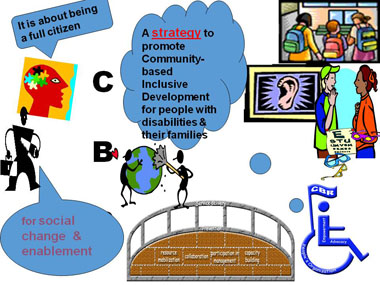 (Slide 2 text)
(Slide 2 text)
Slide 3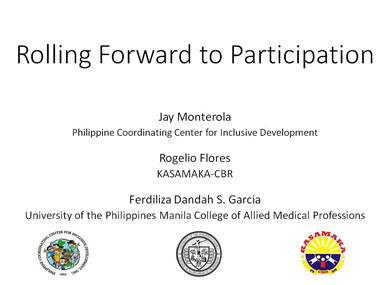 (Slide 3 text)
(Slide 3 text)
Slide 4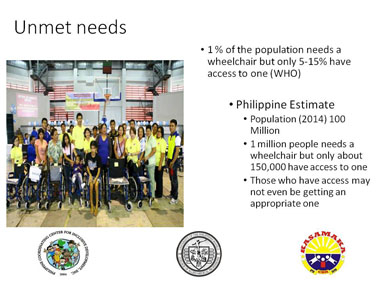 (Slide 4 text)
(Slide 4 text)
Slide 5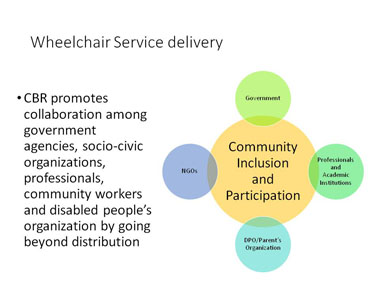 (Slide 5 text)
(Slide 5 text)
Slide 6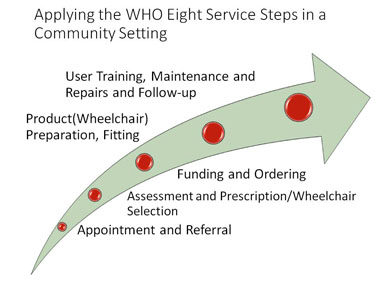 (Slide 6 text)
(Slide 6 text)
Slide 7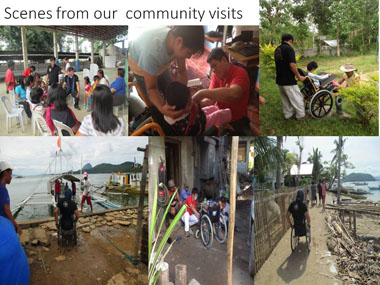 (Slide 7 text)
(Slide 7 text)
Slide 8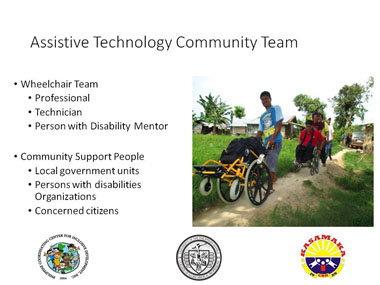 (Slide 8 text)
(Slide 8 text)
Slide 9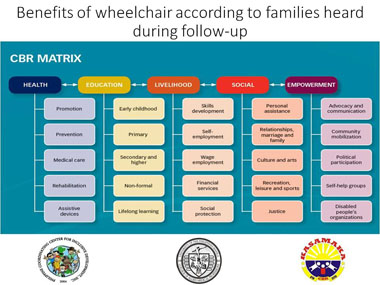 (Slide 9 text)
(Slide 9 text)
Slide 10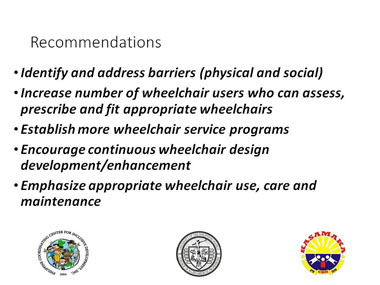 (Slide 10 text)
(Slide 10 text)
Slide 11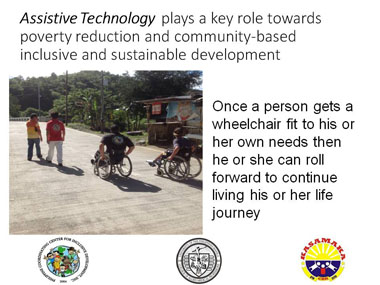 (Slide 11 text)
(Slide 11 text)
Slide 12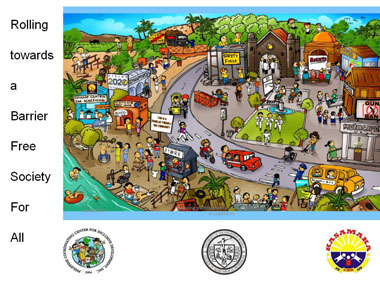 (Slide 12 text)
(Slide 12 text)
